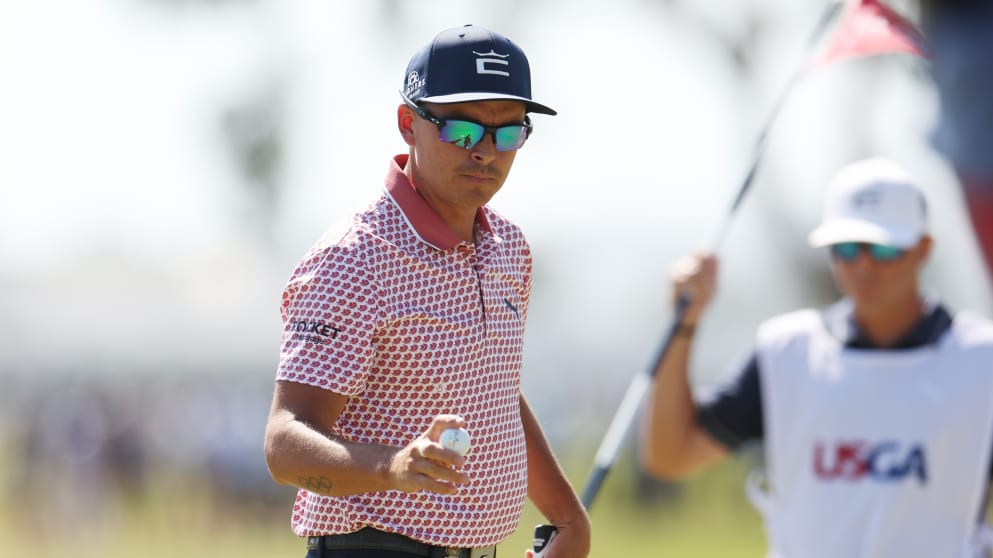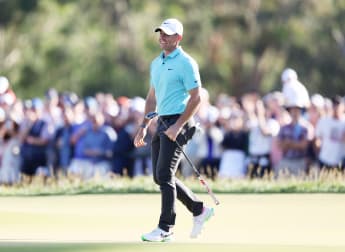An abundance of U.S. Open and Major records were beaten or matched during a history-week at Los Angeles Country Club.
From the lowest ever Major round to the shortest par-three in history and the first man to shoot multiple rounds of 63 in the history of the tournament, we take a closer look at all the note-worthy feats recorded in the 123rd edition of the event.

The lowest round in the U.S. Open (62)
Rickie Fowler and Xander Schauffele wrote their names into Major Championship during the first round of the U.S. Open.
Fowler made ten birdies and two bogeys in a stunning 62 that was the lowest round ever at a U.S. Open and matched the lowest round at a men's Major - posted by Branden Grace at The Open Championship in 2017.
The 34-year-old might have expected to have a commanding advantage after such a stellar performance but he held the solo lead for less than half an hour as fellow United States Ryder Cup star Schauffele also got to eight under after a bogey-free effort.
Tommy Fleetwood: First man to shoot two rounds of 63 in the US Open
Tommy Fleetwood’s final round 63 earned him a top five in this year’s tournament, but it also earned him his own piece of history as he became the first player to have recorded multiple 63s in the U.S. Open.
Fleetwood, who became the sixth player in history to record a 63 in the U.S. Open during the final round at Shinnecock Hills in 2018, added the seventh round of 63 with seven-under-par round on Sunday. He is now the fourth player ever to record multiple rounds of 63 or lower in the four men’s Major championships, joining Greg Norman, Vijay Singh and Brooks Koepka in that achievement.
The most rounds of 63 or less in a men’s Major
With Fowler (62), Schauffele (62) and Fleetwood (63), the 123rd U.S. Open was the first men’s Major championship in history to have three rounds of 63 or lower.
Tommy Fleetwood 🤝 #USOpen final-round 63s
— U.S. Open (USGA) (@usopengolf) June 18, 2023
The only player to accomplish the feat twice! pic.twitter.com/NR41ZdQhGp
The lowest nine-hole score (29)
In this history of the U.S. Open, there had only been four previous times that a score of 29 had been recorded over nine holes. This year, there were two, recorded by Tom Kim and Austin Eckroat, becoming the first U.S. Open to have two 29s recorded in one week.
Kim made history first when he equalled the nine-hole record for the U.S. Open, becoming the first player ever to do that at the event on their first nine. The South Korean made birdies on the first, third, fourth, sixth, eighth and ninth to cover the front nine in just 29 blows.
On Sunday, Eckroat matched Kim to make even more history as he also went out in 29 during the final round – becoming the fifth player to achieve the feat. Neal Lancaster, twice, Vijay Singh and Louis Oosthuizen are the other players to have covered nine holes in 29 shots, all doing so in the second nine of their respective rounds.
The lowest 36-hole total (130)
Rickie Fowler followed up his historic 62 on day one with a 68 on day two for a 130 total that matched the lowest ever at the U.S. Open. His ten under par total left him a shot clear of fellow American Wyndham Clark and two ahead of Rory McIlroy and Xander Schauffele.
It matched the 36-hole scoring record set by Martin Kaymer in 2010 at Pinehurst, where he went on to win by eight strokes.
The fastest player to double figures under par (20 holes)
The U.S. Open has long been regarded as one of the toughest tests in golf and it is a rare feat that a player gets to double figures under par. Fowler was within two of that feat after his opening 62 and a birdie-birdie start on Friday meant he had got there in just 20 holes - the fastest player ever to do so.

The shortest par three in history (81 yards)
During the third round of the U.S. Open, the par-three 15th at The Los Angeles Country Club became the shortest par three hole in history, measuring 81 yards.
There have only been three other par threes under 100 yards in the history of the U.S. Open.
92 yards, 7th, fourth round, Pebble Beach (Calif.) G.L., 2010
98 yards, 13th, third round, Merion G.C. (East Course), Ardmore, Pa., 2013
99 yards, 7th, third round, Pebble Beach (Calif.) G.L., 2010
The second longest par three in history (299 yards)
Just a yard short of tying the record, the par-three seventh hole at LACC became the second-longest in history during the third round of the U.S. Open, measuring 299 yards.
The current record is held by the par-three 8th hole during the fourth round at Oakmont Country Club in 2007, measuring 300 yards. The same hole also measured 299 yards during the fourth round of the U.S. Open in 2016.
The first hole in one by a defending U.S. Open champion (Matt Fitzpatrick)
In the long history of the U.S. Open, no defending champion had ever made a hole-in-one - until Friday. After we had a pair of aces on the 15th on day one, Matt Fitzpatrick made it a hat-trick on day two, which was his first professional hole-in-one.
"As soon as I hit it I thought that it had a good chance of going close anyway," he said. "Dead centre. My hand was a bit sore afterward, I'll be honest, after all the high fiving. It was so exciting to see it and my first ever professional hole-in-one."
https://t.co/PFEB5Asrjt pic.twitter.com/DuEPRugC4d
— DP World Tour (@DPWorldTour) June 16, 2023
The lowest first round scoring average (71.38)
Thursday’s opening round saw many records tumble, including the lowest round scoring average. Six rounds of 65 or better – including Fowler and Schauffele’s 62s - helped the scoring average of the 156-man field to 71.38.
It comfortably bested the previous record of 72.29, which was set at Baltusrol in 1993.
The lowest scores from a player who didn’t win
Rory McIlroy continues his search for a fifth Major title, after finishing one shot behind Wyndham Clark.
His nine under par total for the tournament made for a total score of 271, which is the lowest 72-hole total at a U.S. Open by a player who didn’t win the title.
Longest closing three holes in championship history
The final three holes on the North Course make up the longest combined yardage for the three closing holes in U.S. Open history – their scorecard yardages of 542, 520 and 492 total 1,554 yards.










